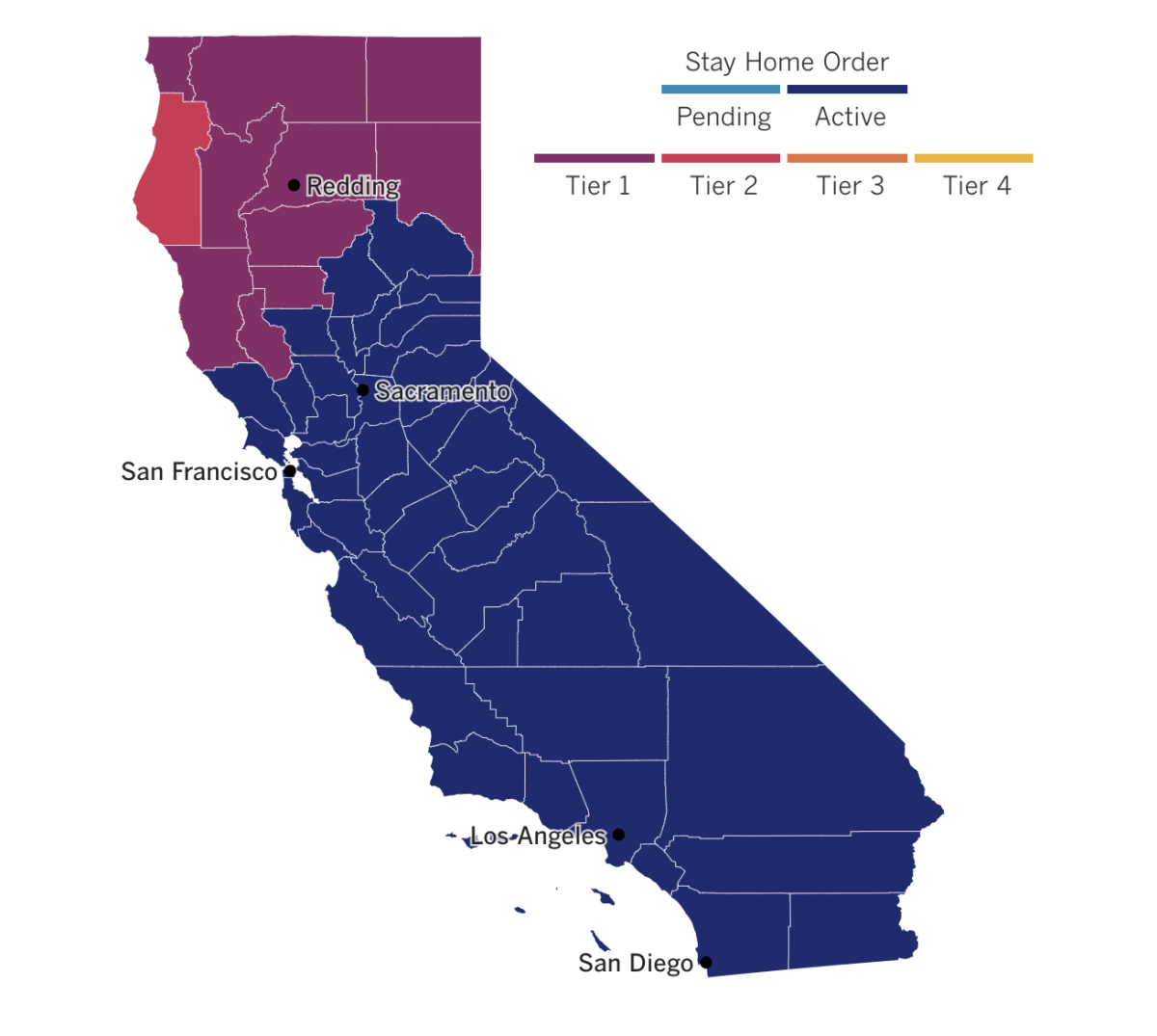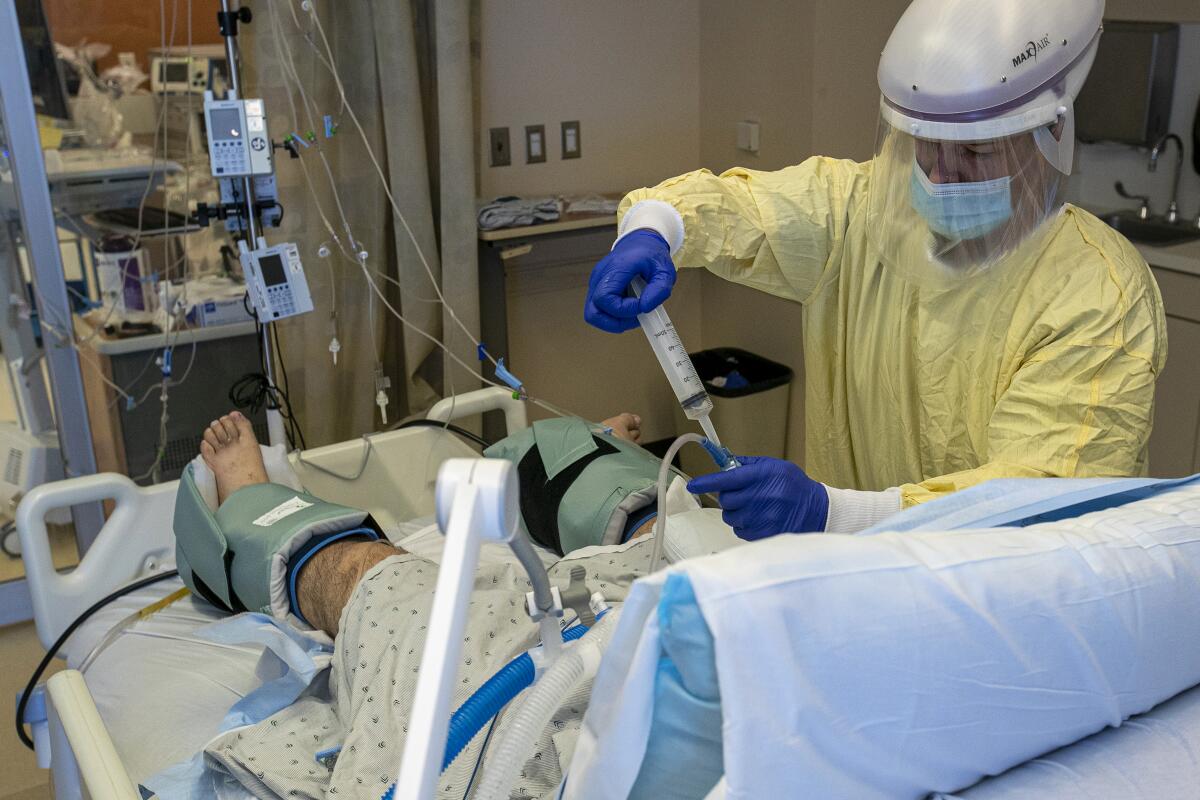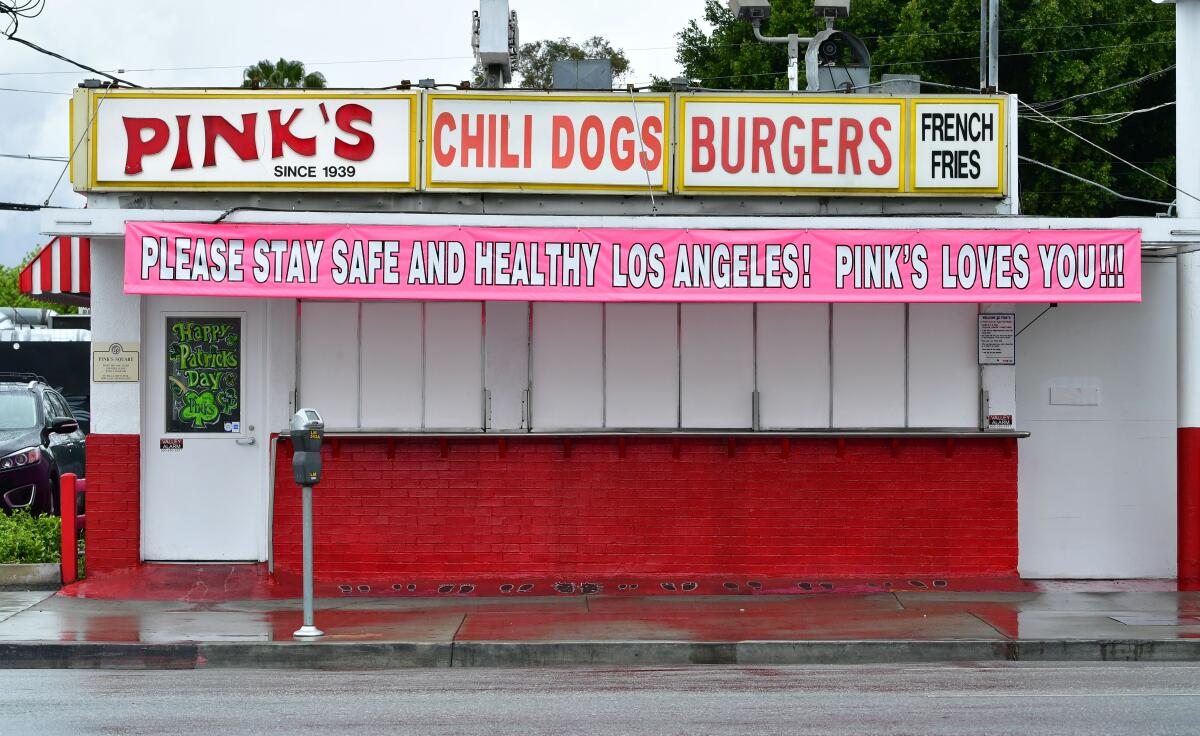Coronavirus Today: L.A.’s testing positives — and negatives
- Share via
Good evening. I’m Amina Khan, and it’s Friday, Jan. 8. Here’s the latest on what’s happening with the coronavirus, plus ways to spend your weekend and a look at some of the week’s best stories.
It’s been exactly one year since Los Angeles County issued its first health alert about the novel coronavirus from China. And on this anniversary, the county set a record for daily COVID-19 deaths.
According to preliminary, still incomplete numbers issued by local health jurisdictions, at least 309 people in the county died of COVID-19 on Friday. That figure easily tops the previous high of 291, logged on New Year’s Eve.
A story by my colleagues Maya Lau and Laura Nelson sheds some light on how we got here by digging into problems with L.A.’s coronavirus testing program.
Back in April, Mayor Eric Garcetti made coronavirus testing available to anyone, regardless of whether they had symptoms of COVID-19. The idea was to identify Angelenos who might not realize they were infected so they’d know to self-isolate and protect others. The move also had the potential to give health officials crucial information to help them track, and possibly slow, the virus’s spread.
But the Food and Drug Administration is warning that testing kits the city has been using carry a “risk of false results, particularly false negative results.”
False negatives are a problem — they cause people to think they’re virus-free and can’t possibly infect others, when the opposite is actually the case. After receiving an erroneous clean bill of health, an infected person could gather with others or take risks they otherwise would not. False negatives also throw off the reported positivity rate, understating the virus’ prevalence in the community.
The tests that were flagged by the FDA this week are made by a Silicon Valley startup called Curative, and they’ve been used at L.A.’s 10 drive-through testing sites since the spring. Unlike nasal swab tests, which have to be administered by a medical professional reaching deep into a patient’s nose, the Curative test is a more comfortable oral swab that people can collect for themselves. That has made it possible for the city to test huge numbers of people without hiring thousands of additional health workers.
But those advantages don’t erase the fact that the company told the FDA in its application for emergency use authorization that the test is “limited to patients with symptoms of COVID-19.” In fact, the company’s study to validate its test excluded people who were asymptomatic.
The new warning from federal regulators reiterates that the Curative test should be used only on people who show signs of illness, and only within 14 days of the onset of symptoms. In such cases, a healthcare worker should observe patients as they use the oral swabs.
All that advice runs counter to the way the tests are being used at L.A.’s drive-through sites.
On Thursday, Garcetti acknowledged that the Curative test is designed for visibly ill people. But he said it catches asymptomatic infections. About a third of the positive test results from the city’s program came from people without symptoms — and that data have helped predict surges in hospitalizations and deaths from COVID-19, the mayor said.
“This is something that has saved lives, will continue to save lives,” Garcetti said. “If we move away from it, I fear we would have a lot fewer people diagnosed and even more spread.”
L.A. County officials saw it differently; they discontinued use of Curative’s oral swab test at their testing sites in June. Public Health Director Barbara Ferrer said at the time that nasal tests produced fewer false negatives.
By the numbers
California cases and deaths as of 6:12 p.m. Friday:

Track the latest numbers and how they break down in California with our graphics.
See the current status of California’s reopening, county by county, with our tracker.


What to read this weekend
Coronavirus Cassandras
Back in October, when it looked like California had the COVID-19 outbreak in hand, researchers at the Institute for Health Metrics and Evaluation used computer models to make an alarming prediction: Even if 95% of U.S. residents wore masks every time they left the house, at least 100,000 more Americans would die of COVID-19 by the end of February. In nine states, including California, the death rate would climb enough to require another lockdown by December.
That seemed surprising at the time: The Golden State was taking the lockdown seriously, largely cutting off indoor dining, shuttering schools and issuing mask mandates. But one really bad surge and another lockdown later, it turns out that the researchers were right. The only matter on which they were off was the size of the surge — it is much larger than even they expected, said Ali Mokdad, a public health professor at the institute.
Mokdad has spoken with my colleague Deborah Netburn about when he thinks the nightmare will end, as well as what factors may influence the virus’ retreat. A few key predictions to keep an eye on: Infections will peak in California on Jan. 27, with 135,800 new cases; peak mortality will follow around Feb. 9, with 652 deaths that day; and the cumulative death toll on April 1 will be at least 70,837. Read their conversation to find out what numbers we should be watching to see if California is turning things around.
A singular victim of COVID-19
Marshall McKay, the 68-year-old Northern California Indigenous leader of Pomo-Wintun heritage, helped secure economic independence for the Yocha Dehe Wintun Nation near Sacramento. A deep supporter of cultural causes, he became the first Indigenous chairman on the board of the Autry Museum and helped steer it from being a “cowboy museum” to a truer reflection of the American West.
He and his wife, Sharon Rogers McKay, were both hospitalized after experiencing severe COVID-19 symptoms. His wife survived; McKay did not.
Rick West, president and chief executive at the Autry, said McKay’s death marks a huge loss not only for the museum but for Native culture at large. West called McKay “one of the five — maybe even three — significant Native leaders in the late 20th century and early 21st century period.”
McKay helped the Yocha Dehe reclaim land in ancestral territories, open a casino to become economically independent and expand into agricultural production with artisanal olive oil. But as a tribal leader, cultural issues were just as important to him as economic ones.
“The economics and the fight for sovereignty — the things I fought for all of my life — I think we’ve got that,” he told the Sacramento Bee in 2006. “Now we need to revitalize our spirituality, our culture — for the young people.”
Younger and sicker
If you’re wondering what kind of region would run a high risk of faring poorly in a pandemic, look to the Inland Empire.
Consider in particular San Bernardino County, where officials have been more resistant to state mandates and stay-at-home orders than those in neighboring Los Angeles County: Last week saw a daily case rate of 744.4 per 100,000 residents. It’s worse in Riverside County, which was logging 941.7 cases per 100,000 residents.
These coronavirus victims are predominantly from Latino, Black and low-income communities, where multigenerational homes and crowded workplaces are common. The region is home to warehouses that have driven up air pollution, which has led to rising rates of asthma — a condition that can worsen the severity of COVID-19.
My colleague Ruben Vives describes troubling scenes at area hospitals, including the Arrowhead Regional Medical Center in Colton, where a 41-year-old man was intubated and placed on dialysis after his kidneys began to fail due to COVID-19.
“That’s our average age that we’re getting,” clinical director Ravneet Mann said. “They’re coming in younger and coming in sicker.”

Angry but hopeful
Gustavo Arellano knows firsthand how the pandemic has damaged small businesses in Southern California: A COVID-19 scare forced his wife to close her Santa Ana market for the Black Friday weekend, the busiest retail weekend of the year. Then, while Arellano stood in front of her closed store, a man walked by and complained that Gov. Newsom’s pandemic restrictions on Southern California were unfair — and that masks didn’t work.
Arellano did his best not to lose his cool. In the end, the shop needed to open, “and spite and malice weren’t going to take out the trash or run the register while my wife whipped up breakfast quesadillas.”
Although there’s a lot of ugliness out there right now, Arellano decided to greet the new year by focusing on stories of pandemic perseverance. He talks about a warehouse worker using his spare time to promote small businesses in La Puente; Mexican families who survived the Juniper Hills fires; a widower in Joshua Tree whose wife died because she couldn’t get the medical aid she needed from hospitals drowning in COVID-19 patients.
“Hobbled or heartbroken, they trudge ahead and shared their stories with me so that they might inspire others to imagine another California,” Arellano writes. Read the full column for a strangely uplifting perspective on the Golden State’s coming year.
Wear your own bubble
Social media star Shay Rose, a 21-year-old UCLA student, has built a following by building handmade whimsical costumes that re-create looks from Disney princesses and Lady Gaga. She recently put her skills to work fashioning a dress that doubles as a social-distancing bubble, with a 6-foot radius (per the recommended guidelines). Two months and 350 feet of very pink tulle later, the finished project had racked up 3.9 million likes and 16.8 million views on TikTok.
“There’s no way it can fit through a door, so it’s in no way ever going to be practical,” Rose said of her gown, which covers 113 square feet. “But my idea behind it was just that question of, ‘Oh, what if? Would this even work? What would it look like?’”
It did work, and it looks fabulous. And of course, it comes with a bubblegum-pink face mask to match.
Your support helps us deliver the news that matters most.
What to do this weekend
Get outside. Take in the sunrise at Malibu’s Charmlee Wilderness Park, whose Ocean Overlook Loop Trail offers sweeping views of the Pacific. Or volunteer to be a nest-watcher with the L.A.-area raptor survey and take notes on owl and hawk nests in Griffith Park and nearby areas. Subscribe to The Wild for more on the outdoors.
Go for a drive. Plan an off-road adventure through the Mojave National Preserve, where you can explore remote stretches of the desert, particularly during wildflower season. Or head out to the Joshua Ranch Loop, a 7.3-mile trail in Palmdale, to catch a glimpse of Joshua trees silhouetted against snowy mountains. Subscribe to Escapes for more California travel ideas.
Watch something great. Our weekend culture watch list includes a streaming of a 2016 London performance of the David Bowie musical “Lazarus,” in honor of the late musician’s birthday and the fifth anniversary of his death. And in his Indie Focus newsletter’s roundup of new movies, Mark Olsen highlights “Pieces of a Woman,” an exploration of a woman working through the grief of losing a baby in childbirth.
Eat something great. Try your hand at this mouthwatering recipe for Korean corn grilled cheese, or forget those resolutions and whip up a batch of flourless fudgy brownies. Sign up for our Cooking newsletter for more.
Go online. Here’s The Times’ guide to the internet for when you’re looking for information on self-care, feel like learning something interesting or want to expand your entertainment horizons.The pandemic in pictures

Pink’s Hot Dogs, the 81-year-old stand at La Brea and Melrose avenues, has shut down voluntarily through at least March as the coronavirus surge continues. Richard Pink, co-owner of the Hollywood institution, said the decision was based on safety, not economics.
“I just couldn’t live with myself and my guilt, if you will, if ... a customer or an employee got sick and they couldn’t get into the hospital,” Pink explained. “I just felt that we’re in a crisis situation.”
Pink said he would pay the roughly 25 employees who are losing work until their unemployment insurance kicks in.
The original stand, which started as a cart on the same corner in 1939, has seen its share of tumult over the decades, including a world war. But no crisis has forced it to close until the pandemic came along, Pink said.
Resources
Practice social distancing using these tips, and wear a mask. Here’s how to do it right.
Watch for symptoms such as fever, cough, shortness of breath, chills, shaking with chills, muscle pain, headache, sore throat and loss of taste or smell. Here’s what to look for and when.
Need to get tested? Here’s where you can in L.A. County and around California.
Americans are hurting in many ways. We have advice for helping kids cope, resources for people experiencing domestic abuse and a newsletter to help you make ends meet.
For our most up-to-date coverage, visit our homepage and our Health section, get our breaking news alerts, and follow us on Twitter and Instagram.




